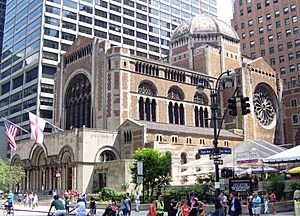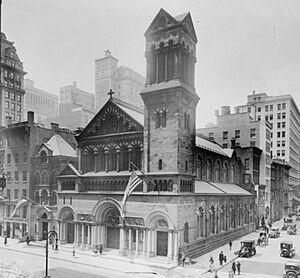St. Bartholomew's Episcopal Church (Manhattan) facts for kids
Quick facts for kids St. Bartholomew's Church |
|
|---|---|
| St. Bartholomew's Episcopal Church | |
 |
|
| Location | 50th Street and Manhattan, New York City |
| Country | United States |
| Denomination | Episcopal Church |
| History | |
| Founded | 1835 |
| Dedication | St. Bartholomew |
| Consecrated | May 1, 1923 |
| Architecture | |
| Architect(s) | Bertram Goodhue McKim, Mead & White |
| Architectural type | Church |
| Style | Romanesque Revival, Byzantine Revival |
| Completed | 1930 |
| Construction cost | $5,400,000.00 (equivalent to $94,596,813 in 2022) |
| Administration | |
| Diocese | New York |
| Province | Province II |
St. Bartholomew's Church, often called St. Bart's, is a famous Episcopal church. It was started in January 1835. You can find it on Park Avenue, between 50th and 51st Street, in Midtown Manhattan, New York City. In 2018, the church celebrated 100 years since its first service in its Park Avenue building.
St. Bart's is a very important example of early 20th-century church design. It was created by the famous architect Bertram Goodhue. Because of its special design, the church and its Community House were named a National Historic Landmark on October 31, 2016.
Contents
Early Church Buildings

The first St. Bart's church opened in January 1835. It was a simple building located at Great Jones Street and Lafayette Place.
The second church was built from 1872 to 1876. It was at Madison Avenue and East 44th Street. James Renwick Jr., who also designed St. Patrick's Cathedral, designed this church. It was built in the Lombardic style.
In 1902–1903, a beautiful triple archway was added to this church. It was designed by Stanford White. He was inspired by a church in France. The archway had amazing bronze doors with detailed pictures from the Bible. Famous sculptors like Andrew O'Connor and Herbert Adams created these doors.
The Current Church Building
The church building you see today was built in 1916–17. The first design by Bertram Goodhue was a Byzantine Revival style. It was described as "a jewel in a monumental setting." Goodhue changed his design to include the old church's beautiful archway and bronze doors. These were moved from the Madison Avenue building to the new site.
The first stone for Goodhue's design was placed on May 1, 1917. The church was ready for services in 1918. After Goodhue passed away in 1924, his partners continued the work. They used special salmon and cream-colored bricks and creamy limestone. They also designed the outdoor terrace. This terrace is now a popular outdoor dining area for the restaurant called Inside Park.
They also added the church's famous dome. It has a tile pattern on the outside and a colorful Hispano-Moresque design inside. This dome replaced a spire that was planned but never built. The church was finished in 1930 and cost $5.4 million. Inside, you can see beautiful stained-glass windows and mosaics by Hildreth Meiere. There is also a marble baptismal font by Bertel Thorvaldsen.
St. Bartholomew's is known for its many programs. People from all over New York City attend services here. It is also the final resting place for famous actresses Lillian Gish and Dorothy Gish, and their mother Mary Gish.
Protecting a Historic Landmark
St. Bartholomew's Church and Community House became a landmark in New York City in 1967. At first, some church leaders did not agree with this decision.
In the 1980s, there was a big discussion about the church's future. Some church members wanted to build a tall office building where the community house and terrace were. They hoped this would help the church's money problems. However, the Landmarks Preservation Commission said no to these plans. The church tried to fight this decision in court, but the courts sided with the Landmarks Commission. The United States Supreme Court decided not to hear the church's appeal in 1991. This meant the landmark status would stay.
In 1992, the St. Bartholomew's Preservation Foundation was created. This group worked to raise money to fix up the church. They repaired the roof, secured the dome, and rebuilt the terrace. The popular restaurant "Inside Park" also opened that year. In 2012, the St. Bartholomew's Conservancy took over this important work.
The church was officially named a National Historic Landmark on November 2, 2016. This recognized its importance as an amazing example of architecture and art. The restoration of the church's famous dome was completed in 2017.
Music at St. Bart's
St. Bartholomew's Church is famous for its music. One of its past choir directors was the well-known conductor Leopold Stokowski. He came to St. Bart's from the United Kingdom.
The church has a huge Skinner Organ Company pipe organ. It is the largest organ in New York City and one of the biggest in the world. It was first played in a concert on December 9, 1930. Another famous music director was Harold Friedell, a composer and teacher.
The church's amazing choir has continued to be excellent under different directors. The Chorister Program brings together children aged 6–18 to sing in the church. This program has even been featured on TV shows like The Today Show and Good Morning America.
Images for kids
-
Angel praying towards relief of the Last Supper in the baptismal chamber north of the altar.
See also
 In Spanish: Iglesia Episcopal de San Bartolomé (Manhattan) para niños
In Spanish: Iglesia Episcopal de San Bartolomé (Manhattan) para niños
- Anglican Communion
- Anglo-Catholicism
- Churches Uniting in Christ
- List of National Historic Landmarks in New York City
- Complete List of Presiding Bishops
- National Register of Historic Places listings in Manhattan from 14th to 59th Streets
- Succession of Bishops of the Episcopal Church in the United States











